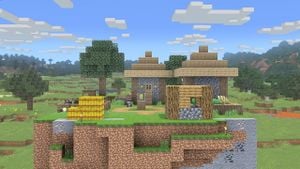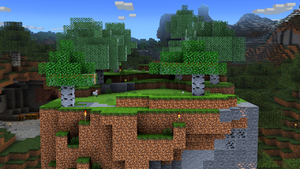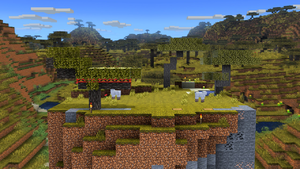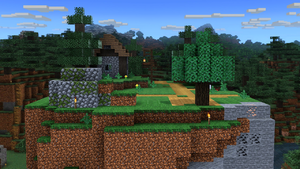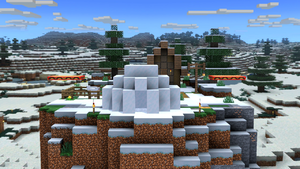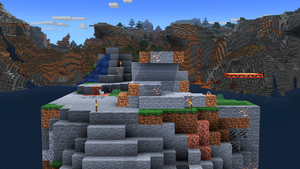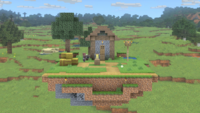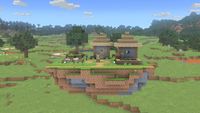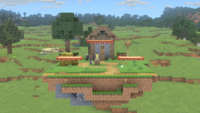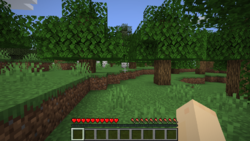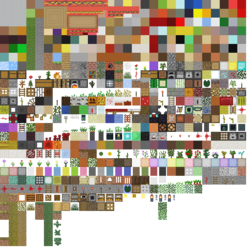Minecraft World
| Minecraft Minecraft World | |
|---|---|
 Minecraft World as it appears in Ultimate. | |
| Universe | Minecraft |
| Appears in | Ultimate |
| Availability | Downloadable |
| Crate type | Normal |
Minecraft World (マインクラフト ワールド, Minecraft World) is a DLC stage in Super Smash Bros. Ultimate. It is bundled with Steve in Challenger Pack 7, which is also part of the Fighters Pass Vol. 2. It was released on October 13th, 2020.
Overview[edit]
The stage is set in Minecraft's Overworld and has a largely standard design, being a flat platform with edges that extend to the lower blast zone. The stage can have six different biomes, each having different arrangements of blocks and soft platforms. The blocks are breakable, will incur 6 frames of hitlag when hit, and will not respawn when broken. Each block has different materials for mining (which will eventually break them) but the large, main platform will give the same materials across the different biomes.
It features a day/night cycle. Two of a randomly selected farm animal (two cows, sheep or chickens) will appear in the background as soon as the stage starts. Some biomes may feature Villagers that perform farmwork during the day and will retire to their homes at night. They can be seen occasionally turning to fighters and watching the battle when close. At nighttime, one to three monsters will appear; these may be a Zombie, an Enderman, a Skeleton, or a Spider, and do not affect gameplay. When morning starts, the monsters will either catch fire and burn up or simply retreat depending on the monster, repeating the cycle.
Normally, the stage randomly loads in different biomes, but a specific biome can be chosen by holding specific buttons before selecting the stage, similarly to Boxing Ring:[1]
- The plains biome is standard, and features a town with two Villagers. Can be loaded by holding
 .
. - The birch forest features two platforms on different levels hidden within birch trees. Can be loaded by holding
 +
+  .
. - The savanna features acacia trees, and one platform hidden with a tree. Can be loaded by holding
 + up on the left
+ up on the left  .
. - The taiga includes mossy stone and a spruce tree. Can be loaded by holding
 + right on the left
+ right on the left  .
. - The snowy tundra includes a single Villager and an igloo in the center. Can be loaded by holding
 + down on the left
+ down on the left  .
. - The stone shore includes a single platform and an irregular stone formation in the center. Can be loaded by holding
 + left on the left
+ left on the left  .
.
All biomes pull elements from Java Edition and Bedrock Edition up to the Nether Update. Any changes or additions to these biomes introduced in later updates starting with the Caves & Cliffs update are not reflected in Ultimate.
Ω form and Battlefield form[edit]
In its Ω form and Battlefield form, the stage always loads in the plains biome, but retains its day/night cycle. It is largely the same other than lacking any hazards and being resized and reshaped to match Final Destination and Battlefield, respectively. The Battlefield form's platforms are similar to those found on the birch forest, savanna, and stone shore biomes. The main stage is set on a grass path rather than varied terrain, since the terrain of Battlefield and Ω stages does not affect which materials can be mined. Unique to this stage, the 8-player Ω form's main platform is completely different from the regular Ω form's platform, rather than simply being a scaled up version of it, presumably for consistency with the size of the stage's blocks.
Hazards off[edit]
With hazards off, the stage will still load one of the six biomes, but all breakable obstacles are removed. The platforms found on the birch forest, savanna, snowy tundra, and stone shore biomes still appear.
Origin[edit]
In Minecraft, worlds are created by choosing the "Create New World" option on the world select screen. Worlds are generated based off of seeds, values that include negative and positive integers. Seeds are either randomly generated by an algorithm or manually generated by the player by typing strings of letters and numbers in the seed bar.
Within a randomly-generated world, there are a number of biomes, which determine the weather, terrain, and mobs that will spawn in that part of the world. The variations of this stage represent a selection of the biomes.
- The plains are the most generic biome: a mostly flat, grassy area filled with typical wildlife such as cows, chickens, pigs, and sheep.
- A birch forest is a variety of forest biome, filled with birch trees and other flora across a hilly landscape. However, like the plains, there are no other particularly unique features.
- The savanna is a warm, mostly flat biome filled with tall grass and acacia trees. It is possible for horses, donkeys, and llamas to spawn in a savanna, and it will never rain. Savannas often border plains and desert biomes.
- Taigas are cold counterparts to forest biomes, filled with spruce trees, sweet berry bushes, and other flora. Rabbits, foxes, and wolves often spawn in taigas.
- The snowy tundra is an uncommon biome filled with flora that has adapted to the cold. Igloos, which often contain treasure chests and other items, can be found in snowy tundras. It is also possible to encounter polar bears and Strays, a variant of the Skeleton mob that has frozen. It only snows in a snowy tundra, rather than raining.
- Stone shores are variants of beach biomes that are usually found bordering mountainous regions. These beaches are filled with varieties of stone rather than sand, and it is common to find waterfalls and lavafalls. Turtles, which are generally found on beaches, cannot spawn in stone shores.
Villages are unique structures that can be found in a variety of biomes, including plains, savannas, snowy tundras, and taigas. The plains variant, which appears in Smash, is the type that has been in the game the longest and represents the most generic village, where villagers farm and live in wooden houses. Villages often contain loot, such as in chests within houses, but it is possible to trade with the villagers for items as well, using emeralds as a currency. At night, all villagers will retreat into their homes to sleep in order to avoid Zombies, lest they be turned into Zombie Villagers or otherwise killed by them.
Tournament legality[edit]
Minecraft World has been seen legal in tournaments infrequently. As the breakable blocks are removed with hazards off and the specific layout can be chosen, there have been talks of making specific forms of the stage legal—specifically the savanna, forest, tundra, and/or stone shore biomes. However, the stage also provides a mild advantage to Steve due to being designed with his mining mechanic in mind, and its size has proven somewhat controversial.
Names in other languages[edit]
Trivia[edit]
- Masahiro Sakurai's original concept for the stage was to include a level editor that would allow stages built in Minecraft to be imported and played in Super Smash Bros. Ultimate. The concept was abandoned early on, as technical issues made it impossible.[2]
- In the texture files for the stage, there are unused block textures for several blocks that don't typically belong with any the six biomes of the stage. This may be a leftover of the scrapped level editor feature, or more biomes for the stage may have been planned.
- The stage's aesthetics are distinctly styled after Minecraft Java Edition. This can be best seen in the tundra biome, as snow does not occupy the same space as plants, unlike in Bedrock Edition.
- However, there is one plant in the background that does occupy the same space as snow, which is only possible in Bedrock Edition.
- The distant backgrounds are 2D panoramic screenshots taken in Java Edition, similar to Great Plateau Tower, and are noticeably lower in quality compared to the stage model. Because all possible worlds in Minecraft can be traced to a specific seed, there is an ongoing fan project to find the seeds used to create these backgrounds.[3]
- While torches are capable of melting snow in Minecraft, the torches in the tundra biome do not melt the snow around them. However, there are torches visible in the skybox of the tundra biome that do appear to melt snow.
- While ice blocks reduce traction in Minecraft, and icy platforms normally reduce traction in Smash, the ice blocks on this stage do not reduce traction.
- One block in Minecraft is one meter (~3.28 feet) wide in all axes. The default form of Minecraft World is 20 blocks long across the X axis, meaning that — assuming the stage uses the same scale — it is 20 meters (~65.62 feet) wide.
- The Ω and Battlefield forms of Minecraft World are 16 blocks long, meaning that they and, by extension, Final Destination and Battlefield (as well as all Ω and Battlefield forms), are 16 meters (~52.49 feet) in length using the same metric.
- In the Spirit Battles for Zombie, Skeleton, and Enderman, the day/night cycle is locked and it is always nighttime, while in the Iron Golem Spirit Battle, the time is locked to daytime. In both cases, the clouds in the sky are also frozen in place, suggesting they are tied to the cycle.
- Minecraft World is the only stage in the game which allows Steve to mine blocks like in actual Minecraft, as any buildings or trees on the stage will crack and break when mined.
- The Nightmare, Tiki, Phosphora, Kapp'n, Nikki, Dillon, Yuri Kozukata, Arcade Bunny, Squid Sisters, and Rathalos Assist Trophies are unable to appear on this stage. Additionally, the Abra, Alolan Exeggutor, Scizor, Gogoat, and Lunala Poké Ball Pokémon are unable to appear on this stage. Coincidentally, the Super Mushroom also cannot appear in the stage.
- Despite this, the Abra Poké Ball Pokémon can appear in the Enderman spirit battle.
- There are numerous texture errors on Minecraft World, such as the snowy tundra using both the new and old snowy grass block textures and the texture for an empty item frame being used in place of the inner texture of the acacia wood in the savannah biome.
- Fans attempting to locate the sources of the stage's background panoramas have discovered evidence to suggest that these images were taken from development versions of 2018's Update Aquatic.[3]
- When skeletons burn in the sunlight, they only flash red and make a hurt sound once, and they use the Zombie's hurt sound instead of their own.
- Masahiro Sakurai revealed in a YouTube video[4] that the stage went through several changes during development:
- The lighting was changed at night so the area around torches would be brighter and everything else would be darker, mimicking the original game.
- Cracks on breakable blocks had their contrast changed to look more like their home game counterparts.
References[edit]
|
| |
|---|---|
| Fighters | Steve (SSBU) (Alex, Zombie, Enderman) |
| Stage | Minecraft World |
| Other | Creeper · Pig |
| Spirits | Spirits |
| Music | Ultimate |
